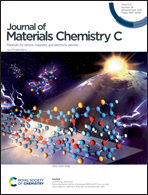A donor–acceptor liganded metal–organic framework showcases the hydrogen-bond-enhanced sensing of N-heterocyclic explosives†
Abstract
The sensitive detection of explosives is urgently required for human security and social stability. Luminescent metal–organic frameworks (MOFs) are attractive but it is challenging to develop versatile all-in-one MOF-based sensors. In this work, we report a novel 3-fold interpenetrating structure Zn(II)-based MOF (ZnMOF-1) for detecting 1,1-diamino-2,2-dinitroethylene (FOX-7)-like emerging energetic compounds. Featuring 2,7-di(pyridin-4-yl)-9H-fluoren-9-one as a donor–acceptor structure ligand, our crystalline ZnMOF-1 achieves a limit of detection of FOX-7-like compounds as low as 0.14 ppm, with a highest fluorescence quenching constant of 3.22 × 104 M−1. The detection mechanism occurring via strong host–guest interactions was found to be intensified due to the hydrogen bonds formed between the MOF and the explosives. Our study is instructive for the design of highly sensitive luminescent MOF sensors for emerging polar donor–acceptor structure explosives.



 Please wait while we load your content...
Please wait while we load your content...